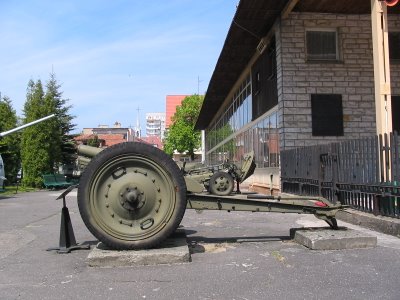 The Weapons the War left behind
The Weapons the War left behindPictured is a Soviet 76mm infantry gun. Infantry guns were organized into batteries at the battalion and regimental levels of many Second World War armies. Their presence gave the battalion or regimental commander "pocket artillery" that was dedicated for his use. Infantry guns were one of many types of weapons that were phased out during or soon after the war, because they were insufficiently mobile or because other weapons systems took over their role.
Other guns that were replaced in the years following the war were anti-aircraft and antitank guns. Although light AA guns remain in the inventories of armies, the heavy pieces were gradually replaced by surface-to-air missiles. Antitank guns had grown so large by the war's end, that their mobility was restricted and their utility correspondingly limited. In the 1950s, France developed the first operational antitank guided missiles (ATGM) with powerful shaped-charge warheads. (The Germans had experimented with a prototype ATGM before the war ended, but it never achieved operational status.) As well, the Germans fielded the first recoilless rifles during the war -- another weapon that used a shaped-charge antiarmor warhead and that weighed far less than a conventional antitank gun. Antitank guns were replaced in large part by ATGMs and recoilless rifles during the 1950s and 1960s.
Likewise, antitank rifles were replaced by antitank rocket launchers. The German Panzerfaust was further developed by the Soviets and fielded as the RPG-2, and later, the RPG-7. After the war, specialized tank destroyer vehicles were gradually replaced by vehicles that mounted ATGMs. As famous as vehicles like the Jagdpanther were, they represented a functional dead-end that ATGM-carrying vehicles could easily surpass.
In the air, specialized dive-bombers faded away after the war, replaced by more general-purpose close-support aircraft. Propellor-driven combat aircraft have almost completely disappeared and have been replaced by jet-propelled aircraft. The first operational jet-propelled combat aircraft were fielded by the Luftwaffe in the final year of the war.
The war also demonstrated beyond a doubt that the era of battleships as a decisive weapon of naval combat was over. The development of naval weapons systems has evolved so dramatically since the war that naval combat today bears almost no resemblance to the actions of the Second World War. Landing craft, while still used, will likely never see another invasion on the scale of D-Day -- for the simple reason that such a massed fleet presents a magnificent target for a tactical nuclear weapon.
The end of the war also saw the first use of atomic bombs. To Germany's great fortune, the Third Reich collapsed before July 1945, else, a German city may well have been the world's first to be devastated by atomic fire.
Less dramatically, but easily as important, was a revolution in infantry warfare launched by Germany with the introduction of the MP43 assault rifle. The assault rifle was destined to replace both bolt-action and semiautomatic rifles, and, to relegate the submachine-gun to use by police and security forces. A near copy of the MP43, the AK47, has become the most widespread and famous assault rifle in the world. The Germans understood perhaps better than any other army of the time that good marksmanship meant far less in a battle than superior firepower -- thus the introduction of automatic rifles that could overwhelm an enemy with heavy fire.

0 Comments:
Post a Comment
<< Home